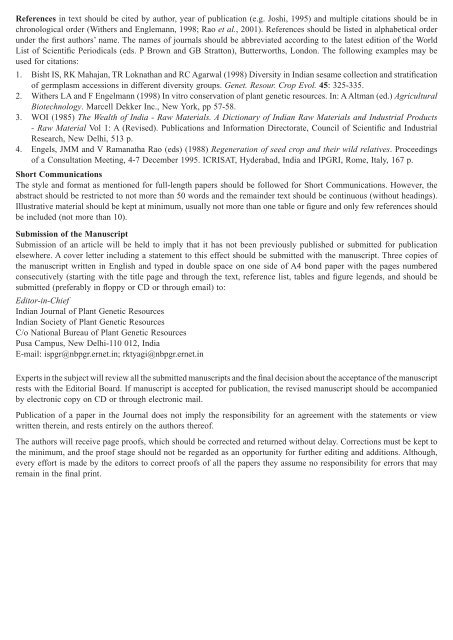indian society of plant genetic resources - Bioversity International
indian society of plant genetic resources - Bioversity International
indian society of plant genetic resources - Bioversity International
Create successful ePaper yourself
Turn your PDF publications into a flip-book with our unique Google optimized e-Paper software.
References in text should be cited by author, year <strong>of</strong> publication (e.g. Joshi, 1995) and multiple citations should be in<br />
chronological order (Withers and Englemann, 1998; Rao et al., 2001). References should be listed in alphabetical order<br />
under the fi rst authors’ name. The names <strong>of</strong> journals should be abbreviated according to the latest edition <strong>of</strong> the World<br />
List <strong>of</strong> Scientifi c Periodicals (eds. P Brown and GB Stratton), Butterworths, London. The following examples may be<br />
used for citations:<br />
1. Bisht IS, RK Mahajan, TR Loknathan and RC Agarwal (1998) Diversity in Indian sesame collection and stratifi cation<br />
<strong>of</strong> germplasm accessions in different diversity groups. Genet. Resour. Crop Evol. 45: 325-335.<br />
2. Withers LA and F Engelmann (1998) In vitro conservation <strong>of</strong> <strong>plant</strong> <strong>genetic</strong> <strong>resources</strong>. In: A Altman (ed.) Agricultural<br />
Biotechnology. Marcell Dekker Inc., New York, pp 57-58.<br />
3. WOI (1985) The Wealth <strong>of</strong> India - Raw Materials. A Dictionary <strong>of</strong> Indian Raw Materials and Industrial Products<br />
- Raw Material Vol 1: A (Revised). Publications and Information Directorate, Council <strong>of</strong> Scientifi c and Industrial<br />
Research, New Delhi, 513 p.<br />
4. Engels, JMM and V Ramanatha Rao (eds) (1988) Regeneration <strong>of</strong> seed crop and their wild relatives. Proceedings<br />
<strong>of</strong> a Consultation Meeting, 4-7 December 1995. ICRISAT, Hyderabad, India and IPGRI, Rome, Italy, 167 p.<br />
Short Communications<br />
The style and format as mentioned for full-length papers should be followed for Short Communications. However, the<br />
abstract should be restricted to not more than 50 words and the remainder text should be continuous (without headings).<br />
Illustrative material should be kept at minimum, usually not more than one table or fi gure and only few references should<br />
be included (not more than 10).<br />
Submission <strong>of</strong> the Manuscript<br />
Submission <strong>of</strong> an article will be held to imply that it has not been previously published or submitted for publication<br />
elsewhere. A cover letter including a statement to this effect should be submitted with the manuscript. Three copies <strong>of</strong><br />
the manuscript written in English and typed in double space on one side <strong>of</strong> A4 bond paper with the pages numbered<br />
consecutively (starting with the title page and through the text, reference list, tables and fi gure legends, and should be<br />
submitted (preferably in fl oppy or CD or through email) to:<br />
Editor-in-Chief<br />
Indian Journal <strong>of</strong> Plant Genetic Resources<br />
Indian Society <strong>of</strong> Plant Genetic Resources<br />
C/o National Bureau <strong>of</strong> Plant Genetic Resources<br />
Pusa Campus, New Delhi-110 012, India<br />
E-mail: ispgr@nbpgr.ernet.in; rktyagi@nbpgr.ernet.in<br />
Experts in the subject will review all the submitted manuscripts and the fi nal decision about the acceptance <strong>of</strong> the manuscript<br />
rests with the Editorial Board. If manuscript is accepted for publication, the revised manuscript should be accompanied<br />
by electronic copy on CD or through electronic mail.<br />
Publication <strong>of</strong> a paper in the Journal does not imply the responsibility for an agreement with the statements or view<br />
written therein, and rests entirely on the authors there<strong>of</strong>.<br />
The authors will receive page pro<strong>of</strong>s, which should be corrected and returned without delay. Corrections must be kept to<br />
the minimum, and the pro<strong>of</strong> stage should not be regarded as an opportunity for further editing and additions. Although,<br />
every effort is made by the editors to correct pro<strong>of</strong>s <strong>of</strong> all the papers they assume no responsibility for errors that may<br />
remain in the fi nal print.

















